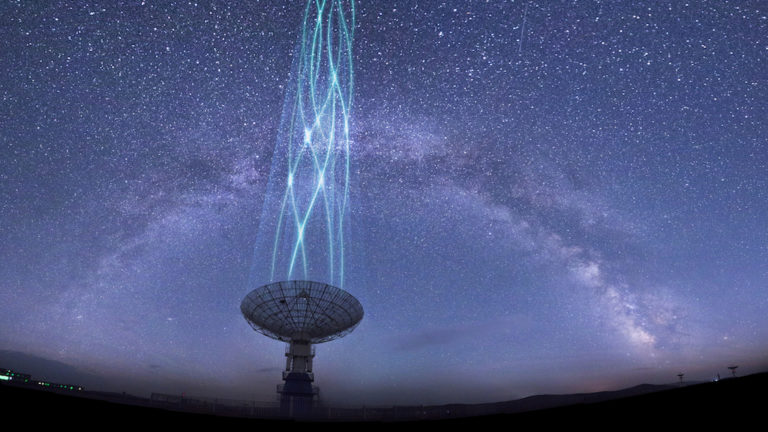Scientists to Broadcast New Message to ETs Across the Galaxy

Scientists are planning a new message for any potential extraterrestrials in the universe, by sending a cosmic ‘hello’ to any intelligent life in space.
When we make contact with extraterrestrials, how will we communicate with them? What if we sent them a message showing information about Earth, humanity, and our technological capabilities?
That was the idea behind the Arecibo message in 1974, designed by Frank Drake and Carl Sagan. The now-famous message was the most powerful broadcast sent into space, from the, now defunct, Arecibo Radio Telescope in Puerto Rico. The binary message consisted of our solar system, strands of DNA, a human figure, and chemicals related to Earth, among other things.
Now, nearly 50 years later an international team of researchers introduced a new message intended for extraterrestrials. The team, led by Jonathan Jiang of NASA’s Jet Propulsion Laboratory, felt it was time to update the Arecibo message since we have come so far technologically since 1974.
The proposed message dubbed “the beacon in the galaxy” will include some similar information as Arecibo, including, “[B]asic mathematical and physical concepts to establish a universal means of communication followed by information on the biochemical composition of life on Earth, the Solar System’s time-stamped position in the Milky Way relative to known globular clusters, as well as digitized depictions of the Solar System, and Earth’s surface.
“The message concludes with digitized images of the human form, along with an invitation for any receiving intelligences to respond.”
But how will they transmit the message into space? The Arecibo Radio Telescope collapsed in December 2020.
The researchers propose using the Chinese Five-hundred-meter Aperture Spherical Telescope, also known as the “FAST” telescope. The FAST telescope is larger than Arecibo and its performance and sensitivity are higher than any other radio telescope in existence.
The SETI Institute’s Allen Telescope Array in California could also be used, but the main problem with both telescopes is they are “receive only” and can not yet transmit messages. Though their research team argues both satellites could be upgraded to send messages with new cutting-edge technology.
“If so profound a goal as communication with alien civilizations is to be realized the powerful tools of fast and data must be paired with an equally well designed and constructed message to transmit.”
This thinking is in line with many experts in space and the search for extraterrestrial life including Harvard professor Avi Loeb, who, when talking about the concept of intelligent life in the universe and how we should look for it, said,
“Well, the most important thing for us is to recognize the possibility that we are not alone and might not be the smartest kid on the block, and what that means is you have to keep your eyes open, rather than assume that we are unique and special and that there is nothing out there,” he said. “It’s sort of like closing yourself off at your home and not looking through the window, — if you do that you would never recognize that you have neighbors, but that will not make the neighbors go away. Just like the fact that philosophers who didn’t look through the telescope of Galileo didn’t make the sun go around the Earth — they didn’t look, they remain ignorant, and the Earth continues to move around the Sun. Reality doesn’t care whether we ignore it or not.”
There is no timeline yet for when “the beacon in the galaxy” could be transmitted, but as Jiang told Scientific American, “[T]his is an invitation to all people on Earth to participate in a discussion about sending out this message… we hope, by publishing this paper, we can encourage people to think about this.”
How to Prepare for Upcoming Solar and Lunar Eclipses

Eclipse season will be here soon, here’s what you can expect and how to prepare for this cosmic dance between the Sun, Moon, and Earth.
Both solar and lunar eclipses hold strong energy in astrology. They can shake us up and stimulate change within ourselves to reach our highest power. We will soon see a partial solar eclipse and a lunar eclipse. What can we expect from these cosmic events?
“Eclipses take place when we have lunar events, which are full moons or new moons that fall close to the nodal axis,” Astrologer Mercedes Arnus Arraut said. “So what is the nodal axis? The nodal axis is the axis of intersection between the orbit of the moon around the Earth and the orbit of Earth around the Sun. That intersection has a north and south, and those points are called nodes. So, the north node represents our destiny; or future, where we’re headed as humanity, what is our destination, what is our direction, where do we need to focus on. In the south, the south node represents our past; what we need to purge, what we need to cleanse, what we need to integrate, what we need to let go…”.
The first eclipse will be on April 30, but Arraut says we will feel it a lot sooner.
“We usually start feeling it around a month before the first eclipse takes place. So, this first eclipse that takes place, the 30th of April, brings many changes into our lives, since all eclipses are like catalysts that align us with our highest purpose. Eclipses literally will cleanse, detox, and be used as tools to show us what path we need to follow,” Arraut said.
Soon after the solar eclipse,we will see a lunar eclipse in May. How does this relate to the solar eclipse we just had?


































